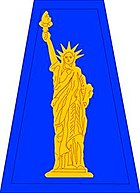77th Infantry Division (United States)
|
77th Infantry Division |
|
|---|---|
 Division badge |
|
| active | 1917, 1942 to 1921, 1946 |
| Country |
|
| Armed forces | United States Armed Forces |
| Armed forces | United States Army |
| Branch of service | infantry |
| Type | Infantry division |
| Nickname | Statue of Liberty |
| Butcher | Second World War |
The 77th Infantry Division ( German 77th US Infantry Division ) was a large unit of the US Army . It has existed since 1963 as the Army Reserve's 77th Sustainment Brigade .
history
First World War
The division was set up on August 18, 1917. The soldiers came mainly from the area of the city of New York and were trained on Long Island on the site of today's Brookhaven National Laboratory . The division therefore has a special relationship with New York and uses an image of the Statue of Liberty as a unit badge. In April 1918, the division landed in France , where it took part in the battle of Château-Thierry in July and later, under the leadership of Major General Robert Alexander, in the Meuse-Argonne offensive . At the beginning of October 1918, a complete battalion of the division was encircled by the Germans in the Argonne south-east of La Viergette, with almost 200 killed and over 100 captured. The affected unit became known as the Lost Battalion . A total of 1486 soldiers of the 77th Infantry Division died by the end of the war, while 8708 were wounded. The division returned to the United States in April 1919, where it was demobilized a little later.
Second World War

The 77th Infantry Division was reactivated in late March 1942 and came to Hawaii in March 1944 for various training sessions . On July 21, she landed on Guam with other American associations . At the side of the 3rd Marine Division she fought against the Japanese defenders until August. The move to Papua New Guinea followed in November of the same year before the division took part in a landing company in Ipil in the Philippines . On December 7th, the 77th Division under Major General Andrew D. Bruce of the XXIV Corps was added as reinforcement on the west side of Leyte and landed south of Ormoc City . Their arrival enabled the 7th Division to continue their advance northward. The fighting in the Philippines did not end until February 1945.
Between March 26 and 29, 1945, the 77th Division finally secured the Kerama Islands in order to form a bridgehead there. After their re-embarkation, their transport ships were attacked from the air on April 2nd and some were badly damaged. The landing on Ie-jima followed on April 16 , where the Japanese troops were eliminated and a strategically important airfield could be conquered. War correspondent and Pulitzer Prize winner Ernie Pyle , who was then serving with the division in the Pacific, was killed. This was followed by participation in the Battle of Okinawa . The 77th Infantry Division landed there on April 25, replacing the 96th Infantry Division. Together they advanced with the 1st Marine Division towards Shuri . After the battle ended, the division was relocated to the Philippines to prepare for an invasion of Japan. After the end of the war on September 2, he was transferred to Japan as part of the occupation forces. In the Second World War 1,449 soldiers of the 77th Infantry Division were killed and 5935 wounded. On March 15, 1946, the association in Japan was dissolved.
In 1963 the division was reorganized under the name 77th Sustainment Brigade . However, it was not sent to the Vietnam War and exists as a reserve unit.
organization
During the First World War, the division was set up as follows:
- 153rd Infantry Brigade
- 306th Infantry Regiment
- 307th Infantry Regiment
- 305th Machine Gun Battalion
- 154th Infantry Brigade
- 307th Infantry Regiment
- 308th Infantry Regiment
- 306th Machine Gun Battalion
- Divisional Troops
During the Second World War, the association was structured as follows:
- 305th Infantry Regiment
- 306th Infantry Regiment
- 307th Infantry Regiment
- 308th Infantry Regiment
- 304th Field Artillery Battalion
- 305th Field Artillery Battalion
- 306th Field Artillery Battalion
- 902nd Field Artillery Battalion
- 302nd Engineer Battalion
- 302nd Medical Battalion
- 77th Ordnance Company
- 77th Quartermaster Company
- 77th Reconnaissance Troop
- 77th Signal Company
Division commanders
- Major General James Franklin Bell (August 18 - December 4, 1917)
- Brigadier General EM Johnson (December 4, 1917 - May 8, 1918)
- Major General George B. Duncan (May 8 - July 20, 1918)
- Brigadier General EM Johnson (July 20 - August 27, 1918)
- Major General Robert Alexander (August 27, 1918 - April 1919)
- Major General Robert L. Eichelberger (March - June 1942)
- Major General Roscoe B. Woodruff (June 1942 - May 1943)
- Major General Andrew D. Bruce (May 1943 - February 27, 1946)
Web links
- 77th Infantry Division at US Army Divisions
- Ours To Hold It High: the History of the 77th Infantry Division in World War II
